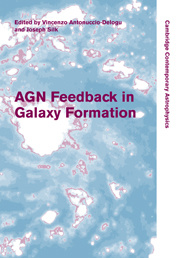Description
AGN Feedback in Galaxy Formation
Cambridge Contemporary Astrophysics Series
Coordinators: Antonuccio-Delogu Vincenzo, Silk Joseph
Suitable for researchers and graduate students in astrophysics, this volume discusses AGN feedback in the context of galaxy formation.
Language: English
Subjects for AGN Feedback in Galaxy Formation:
Publication date: 10-2010
218 p. · 18x25.4 cm · Hardback
218 p. · 18x25.4 cm · Hardback
Description
/li>Contents
/li>Biography
/li>
During the past decade, convincing evidence has been accumulated concerning the effect of active galactic nuclei (AGN) activity on the internal and external environment of their host galaxies. Featuring contributions from well-respected researchers in the field, and bringing together work by specialists in both galaxy formation and AGN, this volume addresses a number of key questions about AGN feedback in the context of galaxy formation. The topics covered include downsizing and star-formation time scales in massive elliptical galaxies, the connection between the epochs of supermassive black hole growth and galaxy formation and the question of whether AGN and star formation coexist. Authors also discuss key challenging computational problems, including jet-interstellar/intergalactic medium interactions, and both jet- and merging-induced star formation. Suitable for researchers and graduate students in astrophysics, this volume reflects the engaging and lively discussions taking place in this emerging field of research.
Part I. AGNs, Starbursts and Galaxy Evolution: 1. The effect of mass and star-formation timescale on galaxy evolution C. Harrison and M. Colless; 2. Suppressing cluster cooling flows by multiple AGN activity A. Nusser; 3. Starbursts and AGN activity in Spitzer-selected sources at high-z M. Polletta, A. Omont, C. Lonsdale and D. Shupe; 4. Star formation in galaxies hosting active galactic nuclei up to z~1 J. Silverman; Part II. Coevolution of Black Holes and Galaxies: 5. The symbiosis between galaxies and SMBHs G. L. Granato, M. Cook, A. Lapi and L. Silva; 6. On the origin of halo assembly bias A. Keselman; 7. AGN, downsizing and galaxy bimodality M. J. Stringer, A. J. Benson, K. Bundy and R. S. Ellis; Part III. Outflows and Radio Galaxies: 8. Interaction and gas outflows in radio-loud AGN - disruptive and constructive effects of radio jets R. Morganti; 9. Young radio sources: evolution and broad-band emission L. Ostorero, R. Moderski, L. Stawarz, M. Begelman, A. Diaferio, I. Kowalska, J. Kataoka and S. J. Wagner; 10. The duty cycle of radio galaxies and AGN feedback S. Shabala; 11. Environments or outflows? New insights into the origin of narrow associated QSO absorbers V. Wild; Part IV. Models and Numerical Simulations: Methods and Results: 12. Physical models of AGN feedback V. Antonuccio-Delogu, J. Silk, C. Tortora, S. Kaviraj, N. Napolitano and A. D. Romeo; 13. Large scale expansion of AGN outflows in a cosmological environment P. Barai; 14. Relativistic jets and the inhomogeneous interstellar medium Geoffrey V. Bicknell, Jackie L. Cooper and Ralph S. Sutherland; 15. AGN feedback effect on intracluster medium properties from galaxy clusters hydrodynamical simulations D. Fabjan, S. Borgani, L. Tornatore, A. Saro and K. Dolag; 16. Physics and fate of jet-related emission line regions M. Krause and V. Gaibler; 17. Cusp-core dichotomy of ellitpical galaxies: the role of thermal evaporation C. Nipoti.
Vincenzo Antonuccio-Delogu is a research astronomer at the Italian National Institute for Astrophysics, Osservatorio Astrofisico di Catania, Italy. His research focuses on dynamics and substructure in clusters of galaxies, parallel N-body simulation codes and galaxy formation and evolution.
Joseph Silk is Savilian Professor of Astronomy at the University of Oxford, and Director of the Beecroft Institute of Particle Astrophysics and Cosmology (BIPAC). His research interests include theoretical cosmology, dark matter, galaxy formation and the cosmic microwave background.
Joseph Silk is Savilian Professor of Astronomy at the University of Oxford, and Director of the Beecroft Institute of Particle Astrophysics and Cosmology (BIPAC). His research interests include theoretical cosmology, dark matter, galaxy formation and the cosmic microwave background.
© 2024 LAVOISIER S.A.S.




